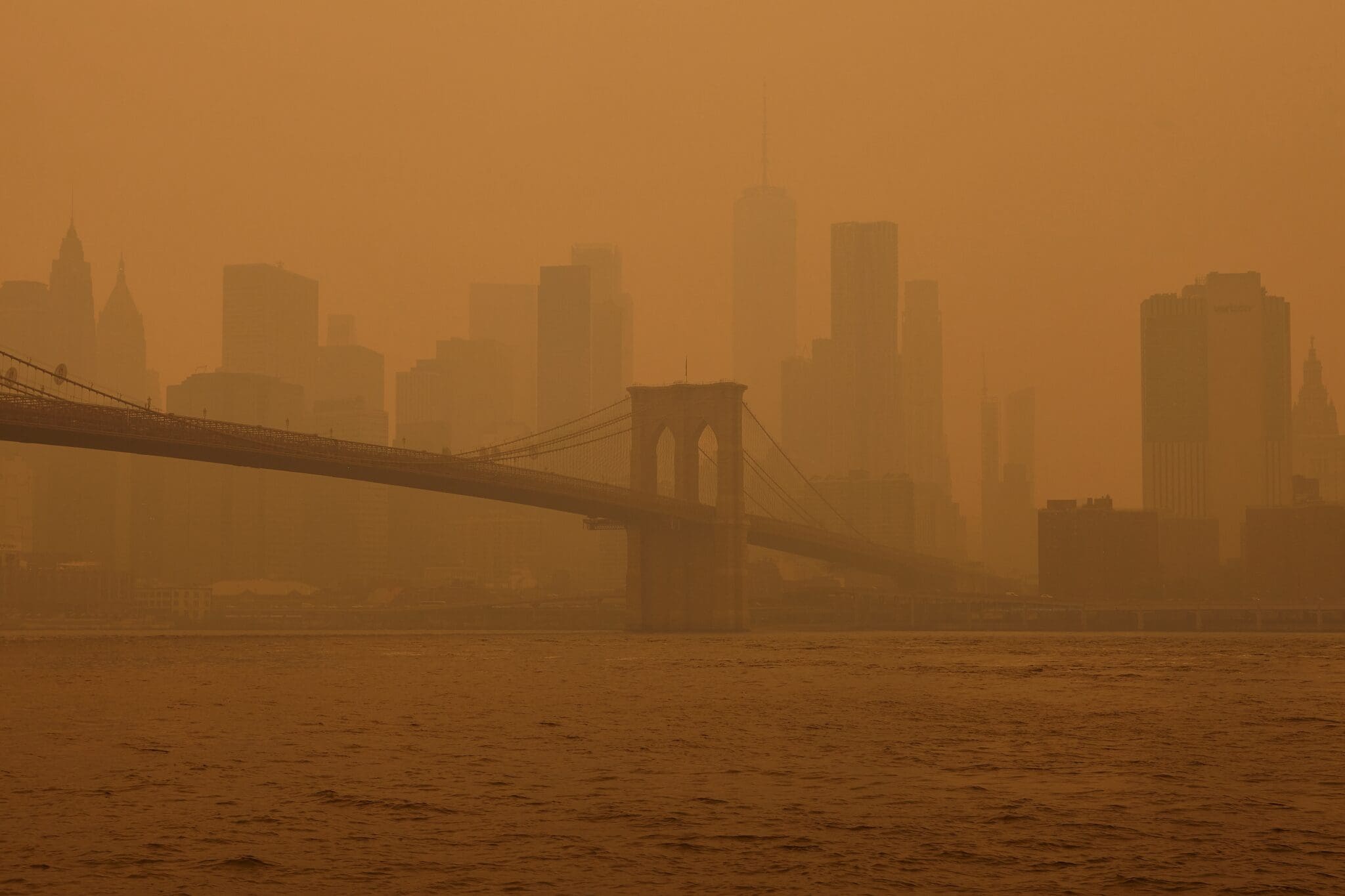Q&A: Atlas’ National Director of Industrial Hygiene and Building Science Alex Peck shares insights into recent air pollution events.
Smoke from Canadian wildfires settled across the U.S. Midwest and eastern seaboard in June, covering major cities in a hazardous haze.
Federal authorities issued health advisories in multiple regions, urging people to remain indoors and monitor the Air Quality Index (AQI) until further notice.
While wildfire phenomena no longer surprise residents of western states, where a Mediterranean climate and landscape create suitable fire conditions, a smoke-veiled, New York City skyline spurred public health concerns about the future.
Can exposure silently harm your health? We caught up with Alex Peck, the National Director of Industrial Hygiene and Building Science at Atlas, to learn more about the effects of wildfire smoke and how to deal with these unprecedented challenges.
How threatening can smoke that’s traveled hundreds of miles away from its source be to human health?
Canada’s fighting more than 400 wildfires at the moment, so it’s difficult to determine the exact source of the smoke. We can presume that the airborne soot impacting New York state and the East Coast comes from western Canada by way of a storm system in Maine, but it’s likely that these fires are burning more than just vegetation and timber.
While breathing particle pollution from any source, including wildfires, can be harmful, if the fires are burning manmade structures and products containing plastics and rubbers, chemically, there’s no telling what you could be inhaling.
And unlike the wildfire smoke that stays aloft in the west, this particular smoke is lingering at ground level.
What is particulate matter?
Particulate matter (PM) refers to the microscopic solid and liquid particles suspended in the air. Although we can’t see these particles individually, they materialize as haze or smoke when present in high concentrations.
We differentiate sizes on a scale from PM10 (particles with a diameter of 10 microns or less) to PM2.5 (particles with a diameter of 2.5 microns or less), or particles 50 times smaller than the diameter of a strand of hair.
The nose and throat can stop many larger PM10 particles from entering our body. Whereas finer, PM2.5 particles, can penetrate deep into lung linings and cause a host of respiratory and cardiovascular issues.
How do you analyze and rate wildfire smoke?
That’s actually one of the biggest challenges in occupational health and safety: we don’t have a good way of doing that right now.
Of course we can analyze the air in a myriad of ways, but the problem is there’s not really one catch-all solution where, to reference Star Trek, we can use a tricorder to gather, compute, and record air quality data.
We have to identify what we believe is in the air and then order the lab to analyze for it. Fires release thousands of toxic chemicals that are typically present in low quantities, making them difficult to capture. That’s one reason why we always focus on PM2.5, because it’s a good marker for just all the pollution in general. PM2.5 also tends to travel further at harmful concentrations than many of the other contaminants.
What smoke detection devices has Atlas installed for clients?
A lot of buildings, especially older models, weren’t built with ventilation systems that can detect particles that come from wildfires.
We recently started installing low-cost sensors that record air quality data in real time. They look like thermostats. They analyze ambient temperature, humidity, particulates, volatile organic compounds (VOCs), and carbon dioxide from people breathing in the building.
It’s new equipment that we can set and forget for 24/7 air quality monitoring. These devices can help our clients understand the impacts of wildfire smoke and other pollution on their indoor environments and employees.
How can Atlas help wildfire-prone properties stay healthy?
Climate scientists expect hotter, drier conditions to extend the fire season. Here’s how Atlas can help:
- Develop custom health and safety plans for employees working in hazardous conditions.
- Perform indoor air quality evaluations amid wildfire events.
- Conduct indoor air quality evaluations after a wildfire/isolated building fire incident to understand impacts and provide guidance for remediation.
The first entails developing a health and safety program for sectors that are exposed to wildfires. It’s geared towards commercial farmers, groundskeepers, delivery drivers, landfill operators, or anyone who primarily works outdoors. We also help businesses comply with wildfire regulations in applicable states.
The second concerns an assortment of different equipment, sensors and sampling devices, and laboratory analyses to assess ventilation system quality. We help determine if the ventilation systems are functioning at full capacity or if improvements are needed.
The third involves testing building surfaces for soot, ash, and char. In most cases, the smoke particles actually stick to surfaces and settle in the dust, which gives off a lingering smoke odor. We perform wipe samples to determine the level of impact to areas within a building and inform remediation plans. Smoke travels through wall cavities in sneaky ways. Basically, we help rid the building of contaminants and the associated smell.
How can individuals own their safety?
Keep an eye on those AQI numbers at AirNow.gov. You can also view various “citizen science” indoor air quality (IAQ) monitoring programs online, such as PurpleAir.com. Some platforms even allow you to opt for a meter that you can set up outside your front door.
If you’re in an area that’s experiencing intense smoke, staying inside is the main recommendation from federal agencies.
Make sure that the air quality inside is as good as it can be. You’ll want to keep windows and doors airtight as best you can. Make sure you’re using the highest rated air filters that your ventilation system allows.
I suggest buying those affordable air purifiers for rooms, too. The one thing that I would note about those is you want to buy one that has a HEPA filter, and you want to pay attention to the Clean Air Delivery Rate (CADR). Get one that’s the right size for the area you’re trying to filter.
Stay away from ionizers. Basically, avoid products that advertise ionization capabilities or ionizing the air. They’re known to produce ozone and other pollutants that you don’t want to breathe. Just stick to HEPA filters. They’re tried and true.

Alex Peck, CIH, MBA
Industrial Hygiene and Building Sciences
Technical Practice Director
Alex Peck is a Certified Industrial Hygienist (CIH) with more than 20 years of experience. He has been consulting most of his career and began at Atlas in 2017. He graduated from Colorado State University with a bachelor’s in environmental health and went on to the University of Utah to obtain an executive master’s in business administration and management.
